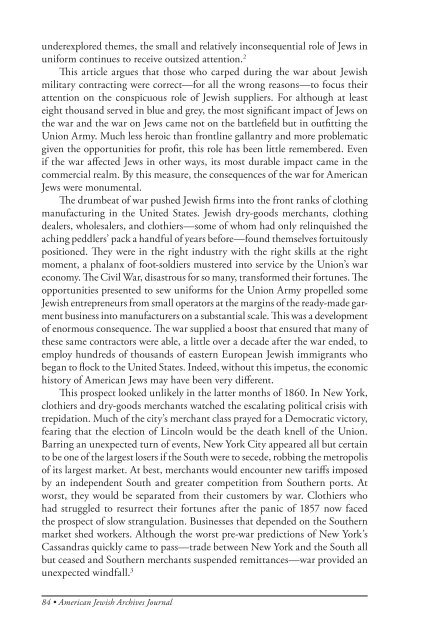American Jewish Archives Journal, Volume 64, Numbers 1 & 2
American Jewish Archives Journal, Volume 64, Numbers 1 & 2
American Jewish Archives Journal, Volume 64, Numbers 1 & 2
You also want an ePaper? Increase the reach of your titles
YUMPU automatically turns print PDFs into web optimized ePapers that Google loves.
underexplored themes, the small and relatively inconsequential role of Jews in<br />
uniform continues to receive outsized attention. 2<br />
This article argues that those who carped during the war about <strong>Jewish</strong><br />
military contracting were correct—for all the wrong reasons—to focus their<br />
attention on the conspicuous role of <strong>Jewish</strong> suppliers. For although at least<br />
eight thousand served in blue and grey, the most significant impact of Jews on<br />
the war and the war on Jews came not on the battlefield but in outfitting the<br />
Union Army. Much less heroic than frontline gallantry and more problematic<br />
given the opportunities for profit, this role has been little remembered. Even<br />
if the war affected Jews in other ways, its most durable impact came in the<br />
commercial realm. By this measure, the consequences of the war for <strong>American</strong><br />
Jews were monumental.<br />
The drumbeat of war pushed <strong>Jewish</strong> firms into the front ranks of clothing<br />
manufacturing in the United States. <strong>Jewish</strong> dry-goods merchants, clothing<br />
dealers, wholesalers, and clothiers—some of whom had only relinquished the<br />
aching peddlers’ pack a handful of years before—found themselves fortuitously<br />
positioned. They were in the right industry with the right skills at the right<br />
moment, a phalanx of foot-soldiers mustered into service by the Union’s war<br />
economy. The Civil War, disastrous for so many, transformed their fortunes. The<br />
opportunities presented to sew uniforms for the Union Army propelled some<br />
<strong>Jewish</strong> entrepreneurs from small operators at the margins of the ready-made garment<br />
business into manufacturers on a substantial scale. This was a development<br />
of enormous consequence. The war supplied a boost that ensured that many of<br />
these same contractors were able, a little over a decade after the war ended, to<br />
employ hundreds of thousands of eastern European <strong>Jewish</strong> immigrants who<br />
began to flock to the United States. Indeed, without this impetus, the economic<br />
history of <strong>American</strong> Jews may have been very different.<br />
This prospect looked unlikely in the latter months of 1860. In New York,<br />
clothiers and dry-goods merchants watched the escalating political crisis with<br />
trepidation. Much of the city’s merchant class prayed for a Democratic victory,<br />
fearing that the election of Lincoln would be the death knell of the Union.<br />
Barring an unexpected turn of events, New York City appeared all but certain<br />
to be one of the largest losers if the South were to secede, robbing the metropolis<br />
of its largest market. At best, merchants would encounter new tariffs imposed<br />
by an independent South and greater competition from Southern ports. At<br />
worst, they would be separated from their customers by war. Clothiers who<br />
had struggled to resurrect their fortunes after the panic of 1857 now faced<br />
the prospect of slow strangulation. Businesses that depended on the Southern<br />
market shed workers. Although the worst pre-war predictions of New York’s<br />
Cassandras quickly came to pass—trade between New York and the South all<br />
but ceased and Southern merchants suspended remittances—war provided an<br />
unexpected windfall. 3<br />
84 • <strong>American</strong> <strong>Jewish</strong> <strong>Archives</strong> <strong>Journal</strong>
















